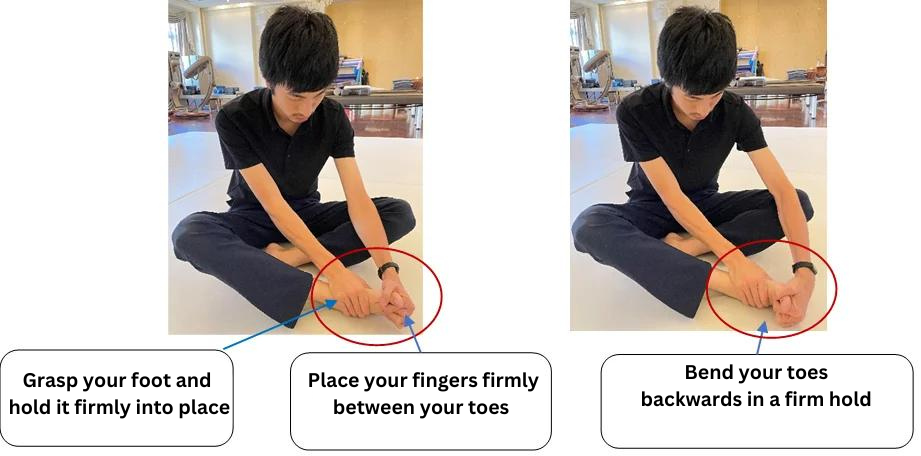Column Do-it-yourself Massages to Relieve Numbness in the Legs Caused by Spinal Stenosis
July 12, 2024
Spinal stenosis is the most prevalent spinal disorder after herniated discs.
In this article, we will introduce stretches and massages that may relieve numbness in the legs resulting from spinal stenosis.
Spinal stenosis and its symptoms
The narrowing of the nerve pathways (i.e., spinal canal) in the spine is called spinal stenosis.
The main symptoms of spinal stenosis are back pain, numbness and soreness in the lower extremities, as well as pain and tingling in the buttocks.
One of its most characteristic symptoms is intermittent claudication. It is a condition in which the patient feels pain and numbness in the legs when walking, but after a short rest, the patient experiences some relief and can walk again, only to feel the pain return after a short period of time. If you have intermittent claudication, even walking 200 to 300 meters can cause such symptoms and make it difficult to walk.

Stretching and massage to relieve numbness in the lower limbs
The purpose of stretching and massages for spinal stenosis is to relieve the stiffness and numbness in the muscles of the lower extremities.
Toe stretch
When standing or walking, if the center of gravity is tilted forward, the muscles that are in charge of flexing the fingers will be continually strained, eventually stiffening the muscles causing numbness in the soles and toes.
Stiffness in the muscles that flex the toes may cause numbness and coldness in the soles and toes.
1. Place the fingers of your hand between your toes while firmly holding the sole of the foot with your other hand so that it does not move.
2. Put the fingers of your hand between the toes and move them in a repetitive motion so as to bend the toes back while the other hand firmly holds the foot in place.
This is more effective if some sort of acupressure is applied to the sole of the foot with the hand that remains immobile to hold the sole of the foot in place when the toes are being flexed.

Single knee stretch
It is important to maintain flexibility of the iliopsoas muscles, the muscles in front of the thighs, as they tend to become stiff, leading to a hunched posture.
1. Stand on one knee with a wall or other support.
2. Pull the kneeling leg back slightly.
3. Bend the knee of the forward leg and stretch the front of the thigh that is in a kneeling position.
Be careful not to turn your back or bend your upper body forward as you do this.

Thigh Stretch
1. Lying on your back, bend one knee so that the sole of your foot does not rest on the bed or any surface.
2. Bend the hip joint about 90 degrees with the sole of the foot floating and hold the foot with your hands behind the knee.
3. Extend the knee while turning the ankle toward you as if you were trying to touch the ceiling with your heel.
4. When the movement becomes a little painful, slowly bend the knee.
Repeat steps 3 and 4.

This stretch can also be done with a towel. Do whichever is easier for you.
・Place the towel on the back of one of your legs and stretch your knee as if you were trying to touch the ceiling with your heel.

Treatments available at our clinics
The Florence and Cellgel methods are both available to treat spinal canal stenosis at our clinics.
The Florence Method
The Florence method is a low-risk, minimally invasive treatment for spinal canal stenosis.
A spacer is inserted percutaneously under partial anesthesia and sedation to widen the narrowed spinal canal. It remains possible to remove the spacer if complications should arise after the treatment has been performed.
The Lobster spacer is inserted inside the vertebral body to stabilize it while preserving spinal rotation and flexion, widening the spinal canal, reducing disc protrusion, and reducing the thickening of the ligamentum flavum. Thus, the narrowed spinal canal is widened, and the pain is relieved.
It is recommended for patients whose condition has failed to improve with conservative treatment and who wish to avoid surgical procedures performed under general anesthesia, such as spinal fusion.
The Celgell Method
Spinal canal stenosis occurs when a disc cracks, causing the central component to protrude and the protruding portion to cause the spinal canal to narrow. If the disc crack is not repaired, herniation can recur, and the spinal canal can become narrowed again.
The Cellgel method used at our clinics provides a fundamental treatment by injecting a drug that fills the cracks in the disc, which then forms a gel that replaces the cracks. It is characterized by the fact that the volume of the disc is not reduced, and the drug remains in the disc as a gel-like implant after treatment, thus preserving the disc.
If you have been diagnosed with spinal stenosis now or in the past, please consider booking a consultation at our clinic.
Related Articles
The Different Symptoms of Spinal Canal Stenosis: If You Have Any of These, It’s a Red Flag!
How to Spend Time after Spinal Stenosis Surgery
Is it already too late! ? What should I do about spinal canal stenosis that has been left untreated?
What are the recommended rehabilitation methods for spinal canal stenosis that you can do yourself?
I don’t want to repeat it again… Points to keep in mind when having stenosis reoperation.
Introduction to our clinic’s post-spinal stenosis surgery rehabilitation program



